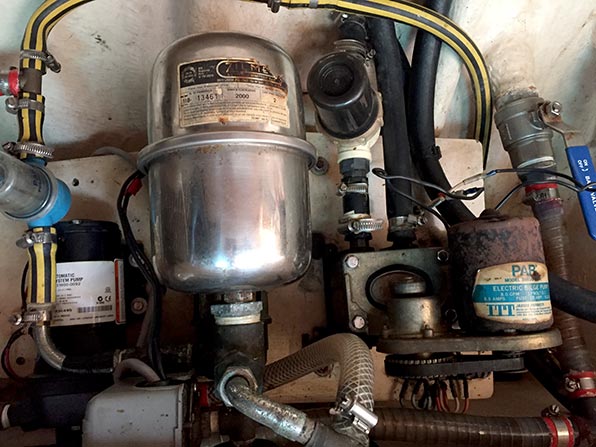A mishmash of tasks
With no clear agenda yesterday, Rebecca and I ended up working on a mishmash of tasks. The day began bright and early with a dinghy ride along the coastline, searching for a cockpit cushion that I (yes, my fault) errantly left on deck overnight. The wind had been honking through the night, and from a consistent direction, so we thought that we’d have a pretty good chance of finding it along the lee shore. Unfortunately, we were unsuccessful, so perhaps it sank. My bad. 🙁
With that unpleasantness behind us, and a couple of cups of coffee in my stomach, I decided to do some cleaning inside our cavernous cockpit locker. Our watermaker lives in a section of that locker, and since we had it running, topping up our tank, I already had the locker open. The watermaker had actually been pickled until two days ago when, after purchasing some new filters, we decided to put it back into service. It took about 45 minutes for me to get it to work, all the while with me sitting inside the locker beside it. I’m not exactly positive what I did to get it going. Perhaps it just wanted some company after resting for so long?

What our cockpit looks like when we drag everything out of our cavernous locker.
Anyway, after removing everything from the locker, I was able to access the fresh water and bilge pumps. I spent some time studying them, cleaning up a bit of the wiring, and replacing some older hose clamps. I walked away a bit confused though as the system appears to have an extra pump installed. In the photo below you’ll see a Jabsco fresh water pump on the left, an accumulator tank in the center, and a belt-driven bilge pump on the right. In the photo below that, you can see that there is actually another, older-looking pump(?) under (attached to) the accumulator tank. Both that pump and the Jabsco appear to turn on when a fresh water tap is opened. I’m not sure of the older pump’s purpose. Perhaps it was original and the Jabsco was added later on? If so, why?

Fresh water pump, accumulator tank, bilge pump.

Extra pump?
In addition to messing with the pumps, we also dug out our emergency tiller. We cleaned it up, installed it, and checked to see how it functioned. I did, prior to this, know where it was located, but yesterday was the first time that we actually put it all together. One of our Facebook friends said that I must have been really bored to have done that. Bored, no. Curious, yes.

Frost’s emergency tiller installed. I wouldn’t want to have to steer like this for very long.

It passes down through the aft cabin to the rudder quadrant.



I’m sure most people know where the emergency tiller is located on their vessel but have never actually installed it to see how it functions. Your curiosity was smart move.
I bet a much smaller number have tried to steer their boat with their emergency tiller. We have yet to do this.
About that older pump ….. When we started out, I installed a very powerful, loud, and amp consuming Jabsco water pump (Paragon Senior) and accumulator tank. When running, the water pump drew about 30A and could be heard throughout the boat. In the fullness of time, I eventually removed that pump and accumulator tank and replaced the two of them with a smaller but nearly as strong quad FLOJET pump – no accumulator tanks required. This pump has been in place and operated without fault for the past 10 years. Whenever you open a tap, this pump kicks in. Your accumulator tank, if correctly set, should provide a buffer and limit the water pump kicking in for just a little bit of water, a squirt to brush your teeth for example. It looks like both of your pumps are providing fresh water. Can you trace the plumbing connections, or remove a contact – to be sure? If its true, then I’d say you’re wasting valuable amps by powering two devices to do the same thing. I’d also suggest that you may need to add pressure to your accumulator tank, there is usually a bicycle pump fitting. That “newer” pump on the left (Jabsco) may not even need an accumulator tank to run……..
I think you’re right, disconnecting one of the pumps (the older one?) and checking to see what happens makes sense.
No worries Michael about steering with the rudder very long, you have Rebecca to do it! Oh, oh, I may be in trouble next time I see you guys! lol
Just need to turn it into a workout. 🙂
Is it possible that’s an AC motor attached to the second pump? Cooling fins on a DC motor are unusual and an AC motor (when AC was available) would operate considerably more quietly.
Good luck…always fun finding gizmos you didn’t know you had!
I don’t think so. It appears to run on DC (there is no AC) but I’ll have to disconnect it to be sure.
Regarding steering: This fall I reported on bending a rudder on a submerged log. I was smoking along at about 8-9 knots when “bam, bam” and the boat started turning. The rudder was pushed back into the hull hard enough that the wheel would not turn, though there was no fiberglass damage. Never did see what I hit. The point is it happens in an instant and does not require a mistake. Also, an emergency tiller won’t help. I recall you have a skeg, so this will probably never happen, but….
Fortunately I was able to trim out the helm with sail adjustments and lowering an engine, and when I got close to where I was headed, I used twin engines to get in. The trip home was a matter of disconnecting the jammed rudder.
Since then I have started working on an article on emergency steering using drogues. Interesting stuff. To my great surprise, you can actually sail most courses with the right rigging, steering with winches rather than the wheel. If I didn’t have 2 rudders, after my last experience, I consider this vital equipment.
While there is more to it than this video let’s on, and I’m still learning, it gives a general idea. As a start, grab the Seabrake out of your PDQ32 (it may actually be the right size for steering the Amel) and give it a try. I’ve been testing a bunch of brands, under many conditions, and Seabrake is pretty good.
http://sail-delmarva.blogspot.com/2016/03/playing-with-drogues.html
http://sail-delmarva.blogspot.com/2016/03/emergency-steering.html
The article will actually end up being quite long (3 parts) and covers emergency steering, sizing, and storm use of drogues.
I always thought of drogues as an ocean thing, but lose a rudder and see how helpless you can be, going in circles.
https://www.youtube.com/watch?v=vupIl68mCYg
Good stuff, Drew. We sold our Seabrake some time ago but Frost did come with a similarly designed drogue. I’m sure it would work in this application. Have you seen the product that I posted about here?
http://www.zerotocruising.com/do-you-have-a-backup-steering-plan/
Looks interesting, but I can’t comment.
If you come across the size and type of drogue that you have, I would be interested.
If I were you I would also spend a few hours “playing” with it on some moderate day. It’s good to work out the kinks, and I have learned that some of the people who write about drogues in books apparently have not actually used them (their instructions don’t work). Funny about that. I came across an article on drogues by Skip Novack, in which he admitted that he had never actually used one, and then expounded on their use. Funny. If you’re going to write about survival by cannibalism, you’ll be more credible after you’ve gnawed a few ankles.
Funny analogy! I’ll send you a pic of the drogue.
I think others are exactly right about the emergency tiller. Knowing where it is is a must, but actually putting it in place and testing it is foolish not to do before going out on any significant voyage. I have done this on every boat I’ve owned, and even at one point tried it out on my previous boat. Not the best way to steer for long periods of time, but if you have no other choice…
It’s akin to ensuring that the bitter end of the anchor rode is tied off. 🙂
I agree about making sure that you can actually steer the boat with the emergency tiller. It looks as though the accumulator tank is dented. Was that exterior trauma, or excess vacuum?
No, it’s not dented Helen.